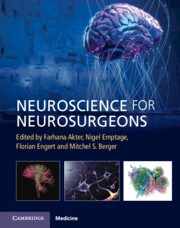Book contents
- Neuroscience for Neurosurgeons
- Neuroscience for Neurosurgeons
- Copyright page
- Contents
- Contributors
- Section 1 Basic and Computational Neuroscience
- Section 2 Clinical Neurosurgical Diseases
- Chapter 12 Glioma
- Chapter 13 Brain Metastases: Molecules to Medicine
- Chapter 14 Benign Adult Brain Tumors and Pediatric Brain Tumors
- Chapter 15 Biomechanics of the Spine
- Chapter 16 Degenerative Cervical Myelopathy
- Chapter 17 Spondylolisthesis
- Chapter 18 Radiculopathy
- Chapter 19 Spinal Tumors
- Chapter 20 Acute Spinal Cord Injury and Spinal Trauma
- Chapter 21 Traumatic Brain Injury
- Chapter 22 Vascular Neurosurgery
- Chapter 23 Pediatric Vascular Malformations
- Chapter 24 Craniofacial Neurosurgery
- Chapter 25 Hydrocephalus
- Chapter 26 Peripheral Nerve Injury Response Mechanisms
- Chapter 27 Clinical Peripheral Nerve Injury Models
- Chapter 28 The Neuroscience of Functional Neurosurgery
- Chapter 29 Neuroradiology: Focused Ultrasound in Neurosurgery
- Chapter 30 Magnetic Resonance Imaging in Neurosurgery
- Chapter 31 Brain Mapping
- Index
- References
Chapter 25 - Hydrocephalus
from Section 2 - Clinical Neurosurgical Diseases
Published online by Cambridge University Press: 04 January 2024
- Neuroscience for Neurosurgeons
- Neuroscience for Neurosurgeons
- Copyright page
- Contents
- Contributors
- Section 1 Basic and Computational Neuroscience
- Section 2 Clinical Neurosurgical Diseases
- Chapter 12 Glioma
- Chapter 13 Brain Metastases: Molecules to Medicine
- Chapter 14 Benign Adult Brain Tumors and Pediatric Brain Tumors
- Chapter 15 Biomechanics of the Spine
- Chapter 16 Degenerative Cervical Myelopathy
- Chapter 17 Spondylolisthesis
- Chapter 18 Radiculopathy
- Chapter 19 Spinal Tumors
- Chapter 20 Acute Spinal Cord Injury and Spinal Trauma
- Chapter 21 Traumatic Brain Injury
- Chapter 22 Vascular Neurosurgery
- Chapter 23 Pediatric Vascular Malformations
- Chapter 24 Craniofacial Neurosurgery
- Chapter 25 Hydrocephalus
- Chapter 26 Peripheral Nerve Injury Response Mechanisms
- Chapter 27 Clinical Peripheral Nerve Injury Models
- Chapter 28 The Neuroscience of Functional Neurosurgery
- Chapter 29 Neuroradiology: Focused Ultrasound in Neurosurgery
- Chapter 30 Magnetic Resonance Imaging in Neurosurgery
- Chapter 31 Brain Mapping
- Index
- References
Summary
Hydrocephalus affects 1/1000 births and is treated using neurosurgical cerebrospinal fluid(CSF) diversion techniques with high complication and failure rates. Recent data on the pathogenesis of acute post-hemorrhagic hydrocephalus(PHH) have implicated an acute Toll-like receptor(TLR4)-dependent hypersecretory response of the choroid plexus epithelium(CPe), the site of highly regulated CSF production and part of the blood–CSF barrier. Post-infectious hydrocephalus(PIH) is the most common form of hydrocephalus worldwide and shares multiple features with PHH, including TLR4-regulated CSF cytokines and immune cells. We introduce the concept of “inflammatory hydrocephalus”, and argue this may more precisely convey the shared pathogenic mechanisms and potential therapeutic vulnerabilities of PHH/PIH than the current concept of “secondary hydrocephalus.” This change of emphasis could shift our view of PHH/PIH from that of lifelong neurosurgical disorders to one of preventable neuroinflammatory conditions. In addition to attenuating acute CPe hypersecretion, early targeting of TLR4 may prevent inflammation-induced brain damage resulting in scarring, obstruction, and poor long-term neurodevelopmental outcomes.
- Type
- Chapter
- Information
- Neuroscience for Neurosurgeons , pp. 335 - 347Publisher: Cambridge University PressPrint publication year: 2024



